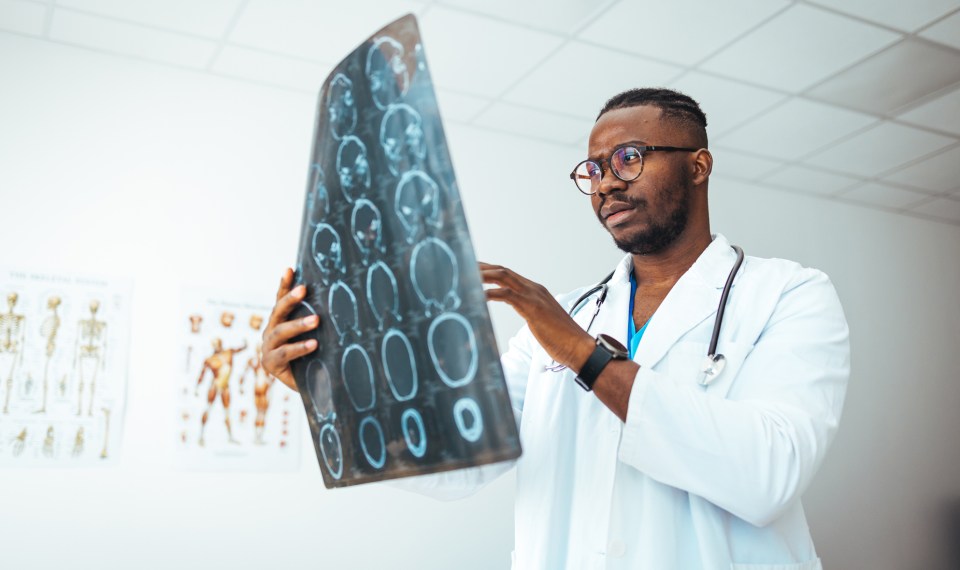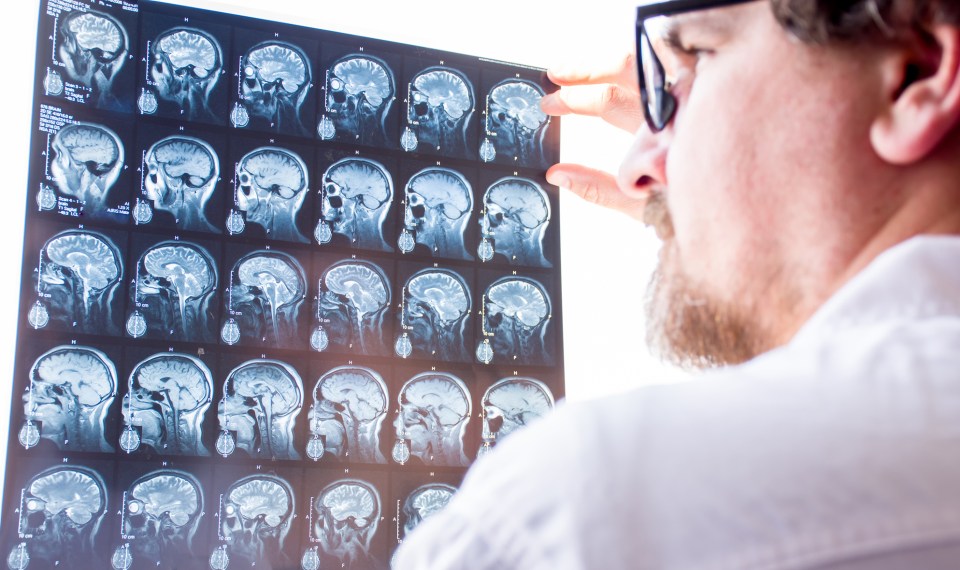Multiple sclerosis (MS) is a chronic condition of the central nervous system. An autoimmune disease, MS attacks the brain, spinal cord and optic nerves. It damages the myelin sheath, the fatty, protective covering that surrounds nerve fibers, causing signal disruption, leading to symptoms that can be short-term or persistent.
There are different types of MS, and the disease is unique to each person. Multiple sclerosis progresses very quickly in some, while others experience a gradual onset with very few or minimal symptoms.
Symptoms of MS
There are many symptoms of MS, and they vary greatly from person-to-person. Some diagnosed with MS have many symptoms while others experience only have a single symptom. Symptoms can also change over time, worsening or improving. Common symptoms include:
- Fatigue. Up to 80% of those with MS experience fatigue.
- Vision disturbances. Often this is the first symptom those with MS experience. Those affected may experience double vision, blurred vision, poor contrast or color vision, eye pain and loss of vision.
- Problems walking. Poor balance, spasticity, sensory deficit, and fatigue can lead to reduced mobility.
- Numbness or tingling. Numbness in the arms, legs, face or body is often an early symptom in MS.
- Weakness. Muscle deterioration due to nerve damage or under use leads to weakness.
- Dysesthesia or MS hug. A common early symptom described as a squeezing sensation around the torso.
- Dizziness or vertigo. Lightheadedness or spinning sensation (vertigo) is sometimes reported by those with MS.
As MS progresses, symptoms continue and include loss of bowel or bladder control, cognitive changes, sexual difficulty, pain, itching, and depression.
Types of MS
The U.S. National Multiple Sclerosis Society currently divides MS into four types, based on disease courses. The four types of MS are defined as follows:
- Clinically isolated syndrome (CIS). The first episode of neurologic symptoms is due to demyelination in the central nervous system. Those who experience one episode of symptoms that lasts 24 hours and is not accompanied by fever or infection are considered to have CIS. Symptoms of clinically isolated syndrome may disappear or partially improve. Not everyone with CIS develops MS, but those who experience multiple episodes may be diagnosed with MS. Since not everyone who experiences a single episode of neurological symptoms goes on to develop MS, diagnosis is difficult and must be made over time. If magnetic resonance imaging (MRI) reveals brain lesions like those seen in MS, it is more likely the individual will develop MS.
- Relapsing-remitting MS (RRMS). The most common form of MS, relapsing-remitting MS is characterized by a flare of symptoms followed by a period of remission. Symptoms are caused by inflammatory attacks on the myelin. Once the attack subsides, remission begins. During remission, patients may experience partial symptoms or no symptoms at all, but the disease does not progress during this time. Symptoms depend on the area of the central nervous system affected. This type of MS affects women at two to three times the rate of men. Individuals with RRMS are typically diagnosed in their 20s or 30s, although the condition can occur earlier or later. Approximately 85% of those with MS are diagnosed with RRMS, although they may later transition into another type of MS. To diagnosis RRMS, there must be damage in at least two separate areas of the central nervous system that occurred at different times. Other diagnostic tools are findings of multiple sclerosis on MRI, along with a history of symptoms and correlating neurological findings.
- Secondary progressive MS (SPMS). Some diagnosed with RRMS will go on to develop secondary progressive MS. As a person moves from relapsing-remitting MS to secondary progressive MS, the inflammatory changes begin to lessen, and fewer relapses occur. However, symptoms worsen since nerve damage or nerve loss has begun. Diagnosis requires a previous history of relapsing-remitting MS. Progression is gradual, so, if symptoms are worsening, a careful review of the changes in symptoms, along with a neurological exam and repeat MRIs are needed to diagnose SPMS.
- Primary progressive MS (PPMS). This type of MS differs from relapsing MS in that there is very little inflammation. The rarest form of MS, only 10-15% of those with multiple sclerosis have primary progressive MS. Symptoms occur when patches of scar tissue (lesions) form in the brain and spinal cord, interrupting nerve signals. Instead of periods of relapse and remission, symptoms gradually worsen from the onset of PPMS. PPMS affects men and women equally, unlike the relapsing types of MS where women are affected at two to three times the rate of men. PPMS typically occurs at an older age, around 10 years later than relapsing MS. Those with this type of MS often have difficulty remaining in the workforce. A diagnosis of primary progressive MS requires a year of disease progression without remission, along with a brain lesion experts identify as typical for those seen in MS and two or more MS lesions in the spinal cord.
Treatment of MS
There is no cure for MS, but it is possible to slow progression, control symptoms and treat relapses. Several medications are available for MS treatment and are administered through various routes, including intravenous (IV), oral and injectable. Medications are helpful in modifying the disease course, managing symptoms, and treating flare-ups.
A short course (three to five days) of high-dose corticosteroids may be used to reduce inflammation in severe exacerbations, but these medications do not provide any long-term benefits. Other treatments are also useful, including H.P. Acthar Gel, a preparation of adrenocorticotropic hormones (ACTH). The gel is given following injection and provides an extended release of ACTH to treat MS relapses in adults. Due to the high cost, use of the gel is limited but may be administered in those who cannot tolerate glucocorticoids. Plasmapheresis, or plasma exchange, is another option when there is a poor patient response to typical steroid treatment.
Inpatient Rehabilitation for MS
Inpatient rehabilitation is beneficial for those living with MS. Early rehabilitation interventions can reduce complications of MS, including contractures, pressure sores and muscle atrophy. Rehabilitation may also be helpful in avoiding falls, improving speech and reducing mood disorders and cognitive issues.
Rehabilitation for MS uses a comprehensive approach that includes physical therapy, occupational therapy, speech and language therapy and vision rehabilitation.
- Physical therapy addresses mobility issues that are common in all types of MS. It can be helpful in reducing pain and spasticity, improving balance, building strength and increasing coordination and flexibility. Therapists can also help in identifying mobility devices that meet the needs of the individual.
- Occupational therapy helps address the challenges of daily living and improve function at home or in the workplace. Occupational therapists work with patients to conserve energy by performing tasks more efficiently. They can recommend adaptive technologies that improve independence and assist individuals in developing strength and improving range of motion through exercise.
- Speech/language therapy is useful for those who have trouble with swallowing, speaking, and breathing. They can also assist with speech issues including articulation, speech volume, voice quality, or slow speech.
- Vision rehabilitation begins with a vision assessment to identify issues that may impede a patient’s ability to navigate their environment. Using technology to retrain the brain on how to effectively use eye movements can reduce deficits and improve vision.
The content of this site is for informational purposes only and should not be taken as professional medical advice. Always seek the advice of your physician or other qualified healthcare provider with any questions you may have regarding any medical conditions or treatments.



